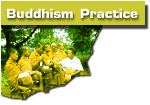 |
BANGKOK
|
||||||||
CENTRAL
|
||||||||||||
NORTHEASTERN
|
||||||||||||||
NORTHERN
|
||||||||||||
SOUTHERN
|
||||
 |
| A GUIDE TO MEDITATION CENTRES IN THAILAND |
| NORTHERN - THAM TONG MEDITATION CENTRE |
MEANING
OF NAME : |
"Tong Cave" |
ADDRESS
: |
Tambon Ban Pae, Amper Chom Thong, Chiang Mai 502400 |
DIRECTIONS
: |
Located 86 km southwest of Chiang Mai. Take a bus from Chiang Mai toward Hot; ask to be let off at the stop for Tham Tong (23 km past Chom Thong, between KM posts 82and 83). Follow the gravel road 1.5 km west to Ban Pae, then turn left 2 km on a small paved road to its end at the meditation centre. You may have to walk in from the highway as local transport is infrequent. |
MEDITATION
SYSTEM : |
Vipassana based on methods taught by Mahasi Sayadaw. The centre is a branch of Wat Maha That in Bangkok; the same meditation system is used. One can also use one's own techniques. |
TEACHING
METHOD : |
The teacher provides instruction for new arrivals, then interviews as needed. |
TEACHERS
: |
Ajahn Suchin Vimalo, abbot (Thai; age 52) |
LANGUAGE
: |
The teacher does not speak English. Visitors need to know basic conversational Thai. A few nuns speak English, but may not be available (especially for male visitors). |
DESCRIPTION
: |
The center covers about 30 rai (12 acres) on both sides of a narrow, wooded valley. A peaceful setting with running stream, caves, and mountains. The land and surrounding mountains belong to the Forestry Department. |
SIZE
: |
monks
7-40 novices 3-10 nuns 15-25 laypeople 10-40 |
DAILY
ROUTINE : |
Wakeup bell is at 330 a.m.; the meal and some chanting is at 830 a.m. One also helps with sweeping and cleaning work. Except for the meal, the entire day is free for individual meditation practice in solitude. |
FOOD
: |
Adequate quality; one meal at 830 a.m. of food offered by the meditation centre. (Newcomers may also be offered a rice porridge earlier in the morning for the first few days.) Monks, novices, and nuns eat from alms bowls but do not go on pindabat. Laymen can eat with the monks and novices; laywomen and nuns have their meal together in an adjacent room. |
ACCOMMODATIONS
: |
Individual kutis (in most cases), fairly close together, or rooms; most have electricity, screens, and Thai-style bathrooms with running water (bathing from tanks; Asian-style toilets). |
WRITE
IN ADVANCE? : |
Recommended. The centre is often full during the Rains Retreat and times of other retreats. |
OTHER
INFORMATION : |
This is a meditation practice center with strict discipline. Visitors must be highly self-reliant and self-motivated. Laypeople wear white clothing and follow 8 precepts. Time should be devoted to meditation and all-around mindfulness. Socializing, reading, and writing are discouraged. |
| Select here : |
|
|